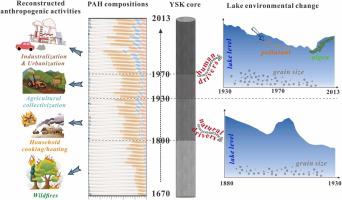当前位置:
X-MOL 学术
›
Anthropocene
›
论文详情
Our official English website, www.x-mol.net, welcomes your feedback! (Note: you will need to create a separate account there.)
Sedimentary records of polycyclic aromatic hydrocarbons and organochlorine pesticides to reconstruct anthropogenic activities in Lake Issyk-Kul region (Kyrgyzstan), and their effects on the lake environment
Anthropocene ( IF 3.6 ) Pub Date : 2024-01-09 , DOI: 10.1016/j.ancene.2024.100426 Qianyu Li , Guo Ru , Jinglu Wu , Miao Jin
Anthropocene ( IF 3.6 ) Pub Date : 2024-01-09 , DOI: 10.1016/j.ancene.2024.100426 Qianyu Li , Guo Ru , Jinglu Wu , Miao Jin

|
Vertical distributions of polycyclic aromatic hydrocarbons (PAHs) and organochlorine pesticides (OCPs) in a sediment core from Lake Issyk-Kul are powerful tools for reconstructing historical anthropogenic activities over the past 350 years. Four periods were identified according to the variations in these environmental proxies. Period Ⅰ (1670s–1800s) corresponds to a phase of limited anthropogenic activity reflected by the lowest ΣPAH concentrations, mainly from biomass combustion and petrogenic processes. Along with pronounced deforestation due to wildfires documented in the pollen record, a similar decrease in PAHs suggests that PAHs were most likely generated by natural sources around Lake Issyk-Kul during this period. Period Ⅱ (1800s–1930s) reflects increasing agricultural activities with fluctuations in various PAH concentrations. Anthropogenic biomass-derived PAH inputs from agricultural activities gradually replaced natural inputs to Lake Issyk-Kul, coinciding with several historical events. However, natural factors still mainly controlled changing lake levels before the 1930s. Period Ⅲ (1930s–1970s) corresponds to rapid development of agricultural activities, inferred by slight increases in ΣPAH concentrations dominated by coal-derived PAHs and a considerable increase in ΣOCP concentrations. Concentrated agricultural activities around Lake Issyk-Kul significantly influenced environmental changes in grain size and water level in the lake. Period Ⅳ (post-1970 s) corresponds to intensive industrial and urban activities, including a 10-year economic depression (1990s–2000s), characterized by the highest ΣPAH concentrations mainly from petroleum combustion followed by a sharp drop after the 1990s as the dissolution of the Soviet Union. Industrialization and urbanization in study area have changed the trophic state of Lake Issyk-Kul, particularly in recent years. Climate change has also induced “lateral remobilization” of contaminants, increasing pollution levels in this mountain lake.
中文翻译:

用于重建伊塞克湖地区(吉尔吉斯斯坦)人类活动的多环芳烃和有机氯农药的沉积记录及其对湖泊环境的影响
伊塞克湖沉积岩芯中多环芳烃 (PAH) 和有机氯农药 (OCP) 的垂直分布是重建过去 350 年历史人类活动的有力工具。根据这些环境指标的变化确定了四个时期。Ⅰ期(1670s-1800s)对应于人类活动有限的阶段,ΣPAH 浓度最低,主要来自生物质燃烧和石油形成过程。除了花粉记录中记录的野火造成的明显森林砍伐之外,多环芳烃的类似减少表明,多环芳烃很可能是这一时期伊塞克湖周围的天然来源产生的。第二阶段(1800年代-1930年代)反映了农业活动的增加,各种PAH浓度的波动。来自农业活动的人为生物质衍生的多环芳烃输入逐渐取代了伊塞克湖的自然输入,这与几个历史事件相吻合。然而,20世纪30年代之前,自然因素仍然主要控制着湖泊水位的变化。第三阶段(1930-1970年代)对应于农业活动的快速发展,以煤源PAHs为主的ΣPAH浓度略有增加,而ΣOCP浓度大幅增加。伊塞克湖周围集中的农业活动显着影响了湖中颗粒大小和水位的环境变化。第四阶段(1970年代后)对应于密集的工业和城市活动,包括10年的经济萧条(1990年代至2000年代),其特点是主要来自石油燃烧的ΣPAH浓度最高,随后随着溶解而在1990年代之后急剧下降苏联的。研究区的工业化和城市化改变了伊塞克湖的营养状态,特别是近年来。气候变化还引发了污染物的“横向再迁移”,增加了这个高山湖泊的污染水平。
更新日期:2024-01-09
中文翻译:

用于重建伊塞克湖地区(吉尔吉斯斯坦)人类活动的多环芳烃和有机氯农药的沉积记录及其对湖泊环境的影响
伊塞克湖沉积岩芯中多环芳烃 (PAH) 和有机氯农药 (OCP) 的垂直分布是重建过去 350 年历史人类活动的有力工具。根据这些环境指标的变化确定了四个时期。Ⅰ期(1670s-1800s)对应于人类活动有限的阶段,ΣPAH 浓度最低,主要来自生物质燃烧和石油形成过程。除了花粉记录中记录的野火造成的明显森林砍伐之外,多环芳烃的类似减少表明,多环芳烃很可能是这一时期伊塞克湖周围的天然来源产生的。第二阶段(1800年代-1930年代)反映了农业活动的增加,各种PAH浓度的波动。来自农业活动的人为生物质衍生的多环芳烃输入逐渐取代了伊塞克湖的自然输入,这与几个历史事件相吻合。然而,20世纪30年代之前,自然因素仍然主要控制着湖泊水位的变化。第三阶段(1930-1970年代)对应于农业活动的快速发展,以煤源PAHs为主的ΣPAH浓度略有增加,而ΣOCP浓度大幅增加。伊塞克湖周围集中的农业活动显着影响了湖中颗粒大小和水位的环境变化。第四阶段(1970年代后)对应于密集的工业和城市活动,包括10年的经济萧条(1990年代至2000年代),其特点是主要来自石油燃烧的ΣPAH浓度最高,随后随着溶解而在1990年代之后急剧下降苏联的。研究区的工业化和城市化改变了伊塞克湖的营养状态,特别是近年来。气候变化还引发了污染物的“横向再迁移”,增加了这个高山湖泊的污染水平。



























 京公网安备 11010802027423号
京公网安备 11010802027423号